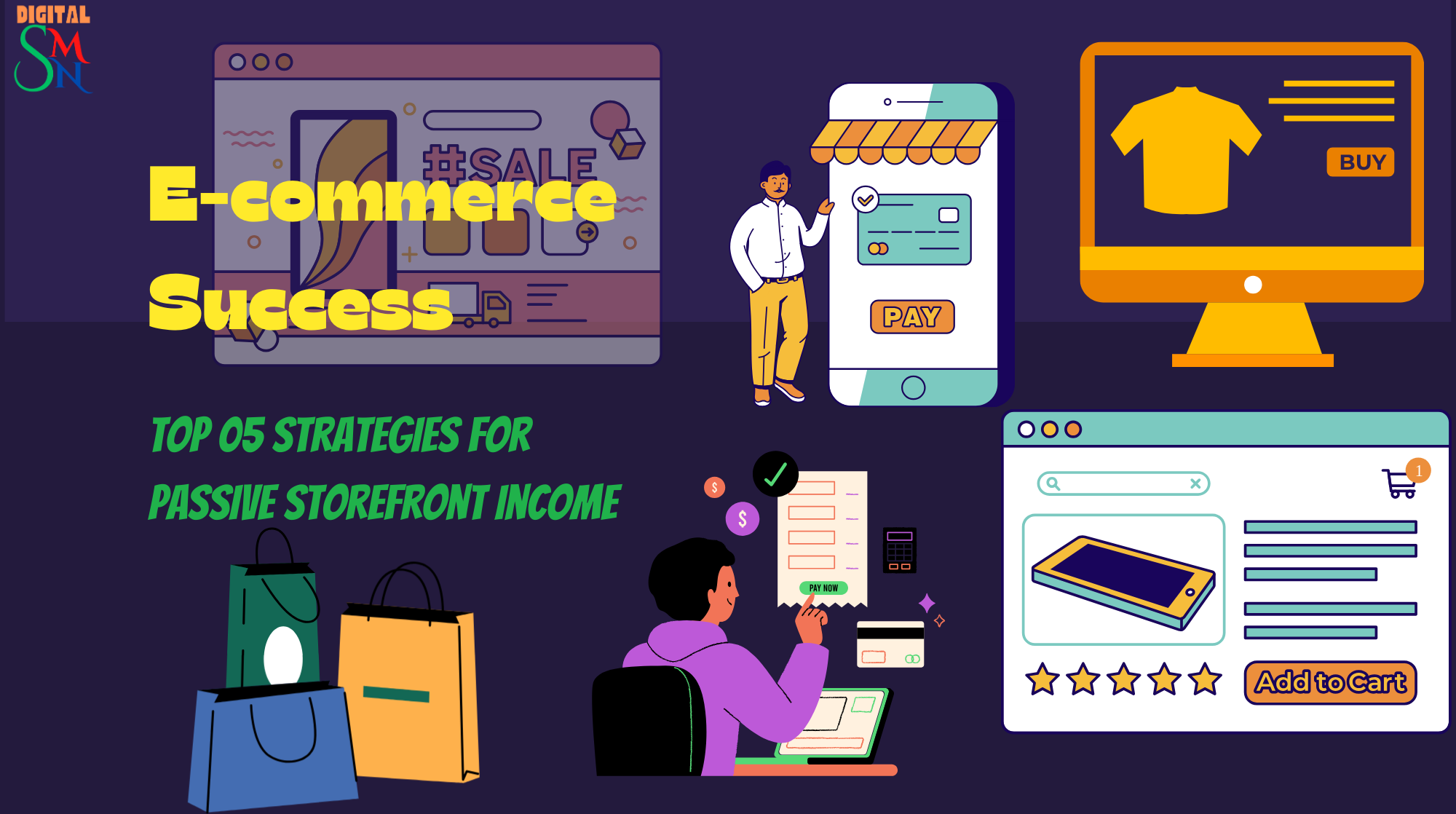In the dynamic landscape of digital entrepreneurship, the allure of establishing a thriving online store beckons with promises of passive income and financial autonomy. This journey into the world of e-commerce, the electronic heartbeat of modern retail, offers boundless opportunities for those seeking to harness the power of the digital storefront. This exploration will unravel the top five strategies for crafting a prosperous e-commerce venture that not only generates income passively but also lays the foundation for sustained success.
From leveraging strategic marketing approaches to optimizing user experiences, this guide will navigate the intricate terrain of e-commerce, providing insights and practical wisdom to steer aspiring entrepreneurs toward a profitable and enduring online presence. Welcome to the realm of E-commerce Success, where the convergence of innovation, strategy, and digital storefronts opens the door to a world of passive income possibilities.
Table of Contents
- Introduction: Navigating the E-commerce Landscape
- Crafting an Irresistible Online Presence
- Leveraging Strategic Marketing Approaches
- Optimizing User Experiences for Maximum Conversions
- Implementing Efficient Order Fulfillment Systems
- Harnessing the Power of Analytics for Informed Decision-Making
- Conclusion: Sustaining Your E-commerce Empire
Introduction: Navigating the E-commerce Landscape
In the vast and dynamic landscape of E-commerce, the possibilities for creating a successful and passive income-generating storefront are immense. As we delve into the intricacies of E-commerce success, our journey begins with understanding the foundational elements of this ever-evolving realm.
Crafting an Irresistible Online Presence
Establishing a robust online presence is the cornerstone of any successful E-commerce venture. From creating an intuitive and visually appealing website to developing a brand identity that resonates with your target audience, this sub-heading explores the key components of building a storefront that stands out in the digital space. We’ll delve into the significance of user interface (UI) and user experience (UX) design, the role of compelling product imagery, and the importance of a clear value proposition.
Leveraging Strategic Marketing Approaches
Once your storefront is in place, the next crucial step is to drive traffic and sales through strategic marketing. This section explores various marketing approaches tailored for E-commerce success. From harnessing the power of social media platforms and influencer marketing to implementing effective email campaigns and search engine optimization (SEO), we’ll uncover the strategies that can propel your E-commerce business to new heights.
Optimizing User Experiences for Maximum Conversions
User experience is paramount in E-commerce, influencing visitors to become customers. Here, we’ll explore the optimization techniques that enhance the user journey, from seamless navigation to persuasive product descriptions. We’ll delve into the significance of responsive design, streamlined checkout processes, and the use of customer reviews to build trust and credibility.
Implementing Efficient Order Fulfillment Systems
Efficient order fulfillment is a key aspect of ensuring customer satisfaction and repeat business. This sub-heading explores various fulfillment models, from in-house operations to third-party logistics (3PL) services. We’ll discuss the importance of inventory management, shipping strategies, and the role of technology in enhancing the overall efficiency of order fulfillment.
Harnessing the Power of Analytics for Informed Decision-Making
In the data-driven era, leveraging analytics is indispensable for making informed decisions. This section unravels the significance of data analytics in E-commerce, from tracking website metrics to understanding customer behavior. We’ll explore tools and platforms that provide valuable insights, enabling businesses to refine their strategies, personalize customer experiences, and optimize their overall operations.
Conclusion: Sustaining Your E-commerce Empire
As our exploration of E-commerce success strategies comes to a close, the concluding section reflects on the key takeaways. We’ll emphasize the importance of continuous adaptation to industry trends, staying customer-centric, and fostering a culture of innovation. This conclusion serves as a roadmap for sustaining and growing your E-commerce empire in an ever-evolving digital landscape.
This comprehensive guide aims to equip aspiring and existing E-commerce entrepreneurs with actionable insights and strategies to build a thriving online storefront and cultivate a stream of passive income.
Read Our Product Review Here
Crafting an Irresistible Online Presence
At the heart of crafting an irresistible online presence for your E-commerce venture lies the creation of a captivating brand identity. This sub-heading delves into the multifaceted aspects of brand development, emphasizing the significance of a cohesive and memorable brand image. We’ll explore the process of designing a distinctive logo, choosing a harmonious color palette, and developing a brand narrative that resonates with your target audience. Real-world examples of successful E-commerce brands with compelling identities will illustrate the impact of a strong brand on consumer perception and loyalty.
Designing an Intuitive and User-Friendly Website
The user interface (UI) and user experience (UX) of your E-commerce website play a pivotal role in determining its success. This section navigates through the principles of designing an intuitive and user-friendly website that enhances the overall shopping experience. Topics covered include the importance of clear navigation, responsive design for mobile users, and the strategic placement of call-to-action buttons. Drawing insights from industry leaders, we’ll highlight best practices and common pitfalls to avoid in website design.
Showcasing Products with Compelling Imagery
Visual appeal is a driving force in E-commerce, influencing purchasing decisions. This sub-heading explores the art of showcasing products with compelling imagery, emphasizing the impact of high-quality photographs and engaging visuals. From the importance of consistent image styles across your product catalog to the use of lifestyle photography, we’ll uncover strategies to make your products visually appealing. Case studies of E-commerce businesses effectively utilizing imagery to boost sales will provide practical insights.
Crafting a Clear Value Proposition
In the competitive landscape of E-commerce, a clear and compelling value proposition is essential for setting your brand apart. This section delves into the process of crafting a value proposition that communicates the unique benefits of your products or services. We’ll explore how to identify and articulate your brand’s unique selling points, aligning them with the needs and desires of your target audience. Real-world examples will illustrate successful E-commerce brands that have effectively communicated their value propositions.
Utilizing Social Media for Brand Building
Social media platforms have become powerful tools for brand building in the E-commerce realm. This sub-heading explores the strategic use of social media to amplify your brand’s online presence. From creating engaging content on platforms like Instagram and Facebook to harnessing the reach of Twitter and LinkedIn, we’ll uncover tactics for building a community around your brand. Case studies will showcase E-commerce businesses effectively leveraging social media for brand awareness and customer engagement.
Elevating Trust Through Customer Reviews
Building trust is paramount in E-commerce, and customer reviews play a crucial role in establishing credibility. This sub-heading explores the significance of customer reviews and strategies for encouraging and managing them effectively. We’ll delve into the impact of positive reviews on conversion rates and how to address negative feedback constructively. Case studies of E-commerce businesses that have successfully utilized customer reviews to build trust and loyalty will provide valuable insights.
Crafting an irresistible online presence for your E-commerce venture involves a strategic combination of visual appeal, brand narrative, and effective communication. This guide aims to equip E-commerce entrepreneurs with actionable insights and real-world examples to enhance their brand’s digital footprint and attract a loyal customer base.
Read Our Product Review Here
Leveraging Strategic Marketing Approaches
In the dynamic landscape of E-commerce, a targeted marketing plan is the linchpin of success. This section delves into the strategic considerations and methodologies involved in crafting a comprehensive marketing plan for your online store. We’ll explore the process of identifying and understanding your target audience, conducting market research to discern trends, and tailoring your marketing strategies accordingly. Real-world examples of E-commerce businesses with successful targeted marketing approaches will provide practical insights into effective planning and execution.
Embracing Content Marketing Strategies
Content marketing is a cornerstone of effective E-commerce strategies, emphasizing the creation and distribution of valuable content to attract and engage a target audience. This sub-heading navigates through the various facets of content marketing, from creating informative blog posts and engaging videos to developing interactive infographics. We’ll explore the importance of aligning content with your brand identity and customer needs, with references to successful E-commerce brands that have leveraged content marketing for heightened visibility and customer loyalty.
Harnessing the Power of Email Marketing
Email marketing remains a potent tool in the E-commerce arsenal, offering direct communication with your audience. This section delves into the art of crafting compelling email campaigns that drive customer engagement and conversions. Topics covered include building and segmenting your email list, creating personalized and targeted email content, and optimizing email campaigns for maximum impact. Real-world case studies will showcase E-commerce businesses effectively leveraging email marketing to nurture customer relationships and drive sales.
Strategic Use of Paid Advertising
Paid advertising is a strategic lever for boosting visibility and driving traffic to your E-commerce store. This sub-heading explores the various avenues of paid advertising, including pay-per-click (PPC) campaigns, display ads, and social media advertising. We’ll delve into the nuances of crafting compelling ad copy, selecting the right platforms for your target audience, and optimizing campaigns for maximum ROI. References to successful E-commerce brands that have strategically employed paid advertising will offer practical insights into this dynamic landscape.
Optimizing for Search Engines (SEO)
Search Engine Optimization (SEO) is paramount for enhancing the online visibility of your E-commerce store. This section navigates through the intricacies of SEO, from on-page optimization techniques to keyword research and link building strategies. We’ll explore the importance of aligning your website with search engine algorithms and staying abreast of industry trends. Real-world examples will illustrate E-commerce businesses that have successfully optimized their online presence, resulting in improved search rankings and organic traffic.
Exploring Affiliate Marketing Opportunities
Affiliate marketing provides a symbiotic relationship where both the E-commerce store and affiliates benefit. This sub-heading explores the dynamics of affiliate marketing, from recruiting affiliates to structuring mutually beneficial partnerships. We’ll delve into the importance of clear communication and incentivizing affiliates, with references to successful E-commerce brands that have effectively incorporated affiliate marketing into their overall strategy.
Measuring and Analyzing Performance Metrics
Effective marketing strategies require continual evaluation and adjustment. This section focuses on the importance of measuring and analyzing performance metrics to gauge the success of your marketing efforts. We’ll explore key performance indicators (KPIs) relevant to E-commerce, such as conversion rates, customer acquisition costs, and return on ad spend. Real-world case studies will provide insights into how E-commerce businesses have utilized performance metrics to refine their marketing approaches and achieve sustained success.
Leveraging strategic marketing approaches in the realm of E-commerce is a nuanced endeavor that requires a holistic understanding of your audience, industry trends, and the ever-evolving digital landscape. This guide aims to equip E-commerce entrepreneurs with actionable insights and real-world examples to navigate the intricacies of strategic marketing and elevate their online store to new heights.
Read Our Product Review Here
Optimizing User Experiences for Maximum Conversions
In the dynamic world of E-commerce, the user’s journey from landing on a website to making a purchase is crucial. This section delves into the strategies for creating a seamless navigation experience that guides users effortlessly through your online store. Topics covered include intuitive website navigation structures, strategically placed calls-to-action, and the importance of mobile responsiveness. Real-world examples of E-commerce brands with exceptional navigation experiences will provide practical insights into optimizing user journeys for maximum conversions.
Streamlining the Checkout Process
The checkout process is the make-or-break point for many E-commerce transactions. This sub-heading explores the intricacies of streamlining the checkout process to minimize friction and encourage conversions. We’ll delve into the importance of a simplified checkout form, transparent pricing, and multiple payment options. Real-world case studies will illustrate how E-commerce businesses have successfully optimized their checkout processes, reducing cart abandonment rates and enhancing overall user satisfaction.
Implementing Personalization Strategies
Personalization is a key driver of user engagement and conversion in E-commerce. This section navigates through the various strategies for implementing personalized experiences on your online store. Topics covered include personalized product recommendations, targeted messaging, and dynamic content. We’ll explore the technology behind effective personalization and showcase E-commerce brands that have mastered the art of delivering tailored experiences, resulting in increased customer loyalty and higher conversion rates.
Enhancing Visual Appeal with High-Quality Imagery
In the visually-driven world of E-commerce, high-quality imagery plays a pivotal role in capturing user attention and fostering trust. This sub-heading delves into the strategies for enhancing visual appeal through compelling product imagery, lifestyle shots, and engaging multimedia elements. We’ll explore the impact of visual aesthetics on user perception and provide insights into successful E-commerce brands that prioritize visual storytelling to elevate their online presence and drive conversions.
Optimizing Load Times for Seamless Browsing
In an era where attention spans are limited, the speed at which your E-commerce website loads can significantly impact user satisfaction and conversion rates. This section explores the importance of optimizing load times for seamless browsing experiences. Topics covered include image optimization, content delivery networks (CDNs), and efficient coding practices. Real-world examples will showcase E-commerce brands that have successfully prioritized load time optimization, resulting in faster, more responsive websites and improved user satisfaction.
Implementing Responsive and Mobile-Friendly Design
With the proliferation of mobile devices, ensuring a responsive and mobile-friendly design is imperative for E-commerce success. This sub-heading navigates through the strategies for implementing designs that adapt seamlessly to various devices. We’ll explore the principles of responsive web design, the importance of mobile optimization, and showcase E-commerce brands that have excelled in providing a consistent and user-friendly experience across desktop and mobile platforms.
Utilizing Social Proof and Customer Reviews
Social proof, in the form of customer reviews and testimonials, can instill trust and confidence in potential buyers. This section delves into the strategies for utilizing social proof effectively on your E-commerce website. Topics covered include the importance of customer reviews, showcasing user-generated content, and leveraging testimonials. Real-world case studies will illustrate how E-commerce brands have harnessed the power of social proof to build credibility and drive conversions.
Optimizing user experiences in E-commerce is a multifaceted endeavor that involves creating a seamless navigation journey, streamlining the checkout process, implementing personalization strategies, and enhancing visual appeal. This guide aims to equip E-commerce entrepreneurs with actionable insights and real-world examples to navigate the intricacies of user experience optimization and maximize conversions on their online stores.
Read Our Product Review Here
Implementing Efficient Order Fulfillment Systems
Efficient order fulfillment begins with a robust inventory management strategy. This section delves into the intricacies of managing your E-commerce inventory effectively. Topics covered include inventory tracking systems, demand forecasting, and the importance of real-time visibility into stock levels. We’ll explore the technology and tools available for streamlined inventory management and provide insights into successful E-commerce brands that have mastered the art of maintaining optimal stock levels for uninterrupted operations.
Utilizing Order Management Systems for Streamlined Processes
Order management systems (OMS) are the backbone of efficient order fulfillment in E-commerce. This sub-heading explores the strategies for implementing OMS to streamline processes from order placement to delivery. Topics covered include order processing automation, real-time order tracking, and the integration of OMS with other E-commerce platforms. Real-world examples will showcase how E-commerce businesses have leveraged advanced order management systems to enhance operational efficiency and provide a seamless experience for customers.
Integrating E-commerce Platforms with Fulfillment Services
Integrating your E-commerce platform with third-party fulfillment services can significantly enhance order fulfillment efficiency. This section navigates through the strategies for seamless integration with fulfillment services, covering topics such as API integrations, order data synchronization, and choosing the right fulfillment partner. We’ll explore case studies of E-commerce brands that have successfully integrated their platforms with fulfillment services, optimizing their logistics and achieving timely deliveries.
Implementing Automation in Packing and Shipping Processes
Automation plays a pivotal role in expediting the packing and shipping processes in E-commerce order fulfillment. This sub-heading explores the strategies for implementing automation technologies, such as robotic packing systems and automated labeling solutions. Topics covered include the benefits of automation in reducing errors, increasing packing speed, and improving overall accuracy. Real-world examples will illustrate how E-commerce businesses have embraced automation to enhance the efficiency of their packing and shipping operations.
Leveraging Technology for Last-Mile Delivery Optimization
The last mile of the delivery process is often the most critical and challenging. This section delves into the strategies for leveraging technology to optimize last-mile delivery. Topics covered include route optimization algorithms, real-time tracking for customers, and the use of drones or autonomous vehicles for deliveries. We’ll explore how technology is reshaping last-mile delivery and showcase E-commerce brands that have implemented innovative solutions to enhance the speed and reliability of their final delivery processes.
Implementing Sustainable Packaging Practices
In an era of increasing environmental consciousness, implementing sustainable packaging practices is not only ethically responsible but also a growing consumer expectation. This sub-heading explores the strategies for adopting sustainable packaging materials, minimizing waste, and optimizing packaging designs for eco-friendly practices. We’ll delve into the benefits of sustainable packaging for both the environment and brand image, providing examples of E-commerce businesses that have successfully incorporated eco-friendly packaging into their order fulfillment processes.
Monitoring and Continuous Improvement for Optimal Performance
Efficient order fulfillment is an ongoing process that requires monitoring and continuous improvement. This section navigates through the strategies for implementing monitoring systems, analyzing performance metrics, and making data-driven improvements. Topics covered include key performance indicators (KPIs) for order fulfillment, implementing feedback loops, and the role of data analytics in optimizing processes. Real-world examples will showcase E-commerce brands that have embraced a culture of continuous improvement in their order fulfillment systems, resulting in heightened operational efficiency and customer satisfaction.
Implementing efficient order fulfillment systems in E-commerce involves strategizing inventory management, utilizing order management systems, integrating with fulfillment services, implementing automation, optimizing last-mile delivery, adopting sustainable packaging practices, and continuous monitoring for improvement. This guide aims to provide E-commerce entrepreneurs with actionable insights and real-world examples to navigate the complexities of order fulfillment and ensure seamless operations in their online stores.
Read Our Product Review Here
Harnessing the Power of Analytics for Informed Decision-Making
In the dynamic realm of E-commerce, leveraging analytics is paramount for making informed decisions. This section begins by providing an overview of E-commerce analytics, emphasizing its role in understanding customer behavior, tracking key performance indicators (KPIs), and gaining actionable insights. Exploring the evolving landscape of analytics tools and technologies sets the foundation for E-commerce businesses to harness the power of data-driven decision-making.
Key Performance Indicators (KPIs) for E-commerce Success
To harness the power of analytics effectively, E-commerce entrepreneurs must identify and track key performance indicators (KPIs) relevant to their business goals. This sub-heading delves into the crucial KPIs that offer insights into various facets of E-commerce operations, including sales performance, customer acquisition cost, conversion rates, and customer lifetime value. Real-world examples will illustrate how successful E-commerce brands strategically utilize KPIs to gauge performance and drive informed decision-making.
Implementing Advanced Customer Analytics
Understanding customer behavior is at the core of successful E-commerce operations. This section explores advanced customer analytics, delving into techniques such as customer segmentation, predictive analytics, and cohort analysis. By deciphering customer preferences, predicting future behaviors, and analyzing customer cohorts, E-commerce businesses can tailor their strategies to enhance customer satisfaction and drive revenue growth. Case studies will highlight how businesses have effectively implemented advanced customer analytics to gain a competitive edge.
Utilizing Web Analytics for Website Optimization
Web analytics is a cornerstone of E-commerce analytics, providing insights into website performance and user interactions. This sub-heading navigates through the strategies for utilizing web analytics tools to optimize the E-commerce website. Topics covered include user journey mapping, conversion funnel analysis, and A/B testing. Real-world examples will showcase how E-commerce businesses have utilized web analytics to enhance website usability, reduce bounce rates, and improve overall user experience.
Analyzing Product Performance and Merchandising Strategies
For E-commerce businesses, understanding which products resonate with customers is crucial for optimizing inventory and driving sales. This section delves into analytics-driven approaches for analyzing product performance, including sales trends, product affinity analysis, and the impact of merchandising strategies. Exploring how analytics can guide inventory management and merchandising decisions will provide actionable insights for E-commerce entrepreneurs aiming to maximize the profitability of their product offerings.
Optimizing Marketing Strategies through Analytics
Effective marketing is integral to E-commerce success, and analytics plays a pivotal role in optimizing marketing strategies. This sub-heading explores the use of analytics in assessing the performance of various marketing channels, measuring the return on investment (ROI), and refining marketing campaigns based on data-driven insights. Real-world examples will showcase how E-commerce brands have utilized analytics to allocate marketing budgets effectively, identify high-performing channels, and optimize ad targeting for maximum impact.
Navigating Social Media Analytics for Brand Engagement
Social media has become a powerful channel for E-commerce brand engagement, and analytics is instrumental in gauging the effectiveness of social media strategies. This section delves into social media analytics, covering metrics such as engagement rates, reach, and sentiment analysis. Exploring how E-commerce businesses can leverage social media analytics to enhance brand visibility, foster customer engagement, and adapt their social media strategies based on performance insights will be illustrated through case studies.
Implementing Predictive Analytics for Future Success
Predictive analytics takes E-commerce analytics to the next level by forecasting future trends and behaviors. This sub-heading explores the principles of predictive analytics, including machine learning algorithms and data modeling. By predicting customer preferences, demand patterns, and market trends, E-commerce businesses can proactively adjust their strategies for future success. Real-world examples will highlight how businesses have successfully implemented predictive analytics to gain a competitive advantage and stay ahead in the dynamic E-commerce landscape.
Ensuring Data Security and Compliance
As E-commerce businesses delve into the realm of analytics, ensuring the security and compliance of customer data is paramount. This section explores strategies for safeguarding customer information, complying with data protection regulations, and maintaining the ethical use of analytics. Topics covered include data encryption, compliance with GDPR and other data protection laws, and the ethical considerations of utilizing customer data for analytics purposes. Real-world examples will underscore the importance of prioritizing data security and compliance in E-commerce analytics initiatives.
Continuous Learning and Adaptation in the Analytics Journey
The E-commerce landscape is ever-evolving, and successful businesses embrace a culture of continuous learning and adaptation. This concluding sub-heading emphasizes the importance of ongoing education and adaptation in the analytics journey. Exploring resources for staying updated on analytics trends, fostering a data-driven culture within the organization, and adapting strategies based on changing market dynamics will provide E-commerce entrepreneurs with insights to navigate the analytics journey successfully.
Harnessing the power of analytics for informed decision-making in E-commerce involves understanding the landscape of E-commerce analytics, identifying key performance indicators (KPIs), implementing advanced customer analytics, utilizing web analytics for website optimization, analyzing product performance and merchandising strategies, optimizing marketing strategies through analytics, navigating social media analytics for brand engagement, implementing predictive analytics for future success, ensuring data security and compliance, and embracing continuous learning and adaptation in the analytics journey. This comprehensive guide aims to equip E-commerce entrepreneurs with actionable insights, real-world examples, and the knowledge needed to leverage analytics effectively in their businesses.
Read Our Product Review Here
Conclusion: Sustaining Your E-commerce Empire
In the ever-evolving landscape of E-commerce, strategic adaptation is not just a choice; it’s a necessity. This section emphasizes the importance of adapting strategies to meet changing market dynamics. Drawing on real-world examples, it explores how successful E-commerce empires have navigated industry shifts, embraced emerging technologies, and adjusted their business models to ensure long-term viability.
Customer-Centric Approach for Sustained Growth
A customer-centric approach is the bedrock of sustained success in E-commerce. Delving into the strategies employed by industry leaders, this sub-section highlights the significance of understanding customer needs, providing exceptional customer service, and fostering brand loyalty. Real-world case studies underscore how E-commerce giants have prioritized customer satisfaction, leading to sustained growth and a loyal customer base.
Global Expansion: Tapping into New Markets
Global expansion is a pivotal strategy for scaling an E-commerce empire. This part explores how successful E-commerce brands have ventured into international markets, addressing challenges such as cultural nuances, legal considerations, and logistics. Analyzing case studies, it provides insights into the steps taken by companies to navigate the complexities of global expansion and establish a robust presence in diverse markets.
Innovations in Technology: Staying Ahead of the Curve
Remaining at the forefront of technological innovations is non-negotiable for E-commerce sustainability. This sub-section investigates how pioneering E-commerce empires have embraced cutting-edge technologies, such as artificial intelligence, augmented reality, and blockchain. By understanding how technology can enhance user experiences and streamline operations, businesses can position themselves as industry leaders.
Sustainable Practices: The E-commerce Responsibility
In the contemporary business landscape, sustainability is a responsibility that extends to E-commerce. This part explores how leading E-commerce brands integrate sustainable practices into their operations, from supply chain management to packaging. Examining eco-friendly initiatives, it sheds light on how sustainable practices contribute not only to corporate social responsibility but also to the long-term resilience of E-commerce empires.
Strategic Partnerships and Collaborations
Strategic partnerships and collaborations are powerful tools for E-commerce sustainability. This sub-heading investigates how successful E-commerce brands have formed alliances with other businesses, influencers, or industry leaders to enhance their reach, credibility, and offerings. Analyzing case studies, it provides insights into the mutually beneficial collaborations that have fueled sustained success in the E-commerce arena.
Resilience in the Face of Challenges
Challenges are inevitable in the dynamic world of E-commerce, and resilience is key to overcoming them. This section explores how E-commerce empires have demonstrated resilience in the face of challenges such as economic downturns, technological disruptions, and global crises. Drawing on real-world examples, it provides actionable insights for businesses aiming to build resilience into their core strategies.
Strategies for Managing Cybersecurity Risks
In an era dominated by digital transactions, managing cybersecurity risks is paramount for E-commerce sustainability. This sub-section explores the strategies employed by successful E-commerce brands to safeguard customer data, prevent cyber threats, and build trust in online transactions. Analyzing industry best practices, it sheds light on the proactive measures taken by E-commerce empires to mitigate cybersecurity risks.
Continuous Evolution: A Mandate for E-commerce Success
The E-commerce journey doesn’t conclude; it evolves. This concluding sub-heading underscores the imperative of continuous evolution. It explores how successful E-commerce empires embrace a culture of innovation, learning, and adaptation. Drawing on examples of businesses that have stood the test of time, it emphasizes the need for an agile mindset to navigate the ever-changing E-commerce landscape.
In conclusion, sustaining an E-commerce empire involves strategic adaptation, a customer-centric approach, global expansion, embracing technological innovations, integrating sustainable practices, forming strategic partnerships, demonstrating resilience, managing cybersecurity risks, and embracing continuous evolution. By drawing insights from real-world examples and industry best practices, this comprehensive guide equips E-commerce entrepreneurs with the knowledge and strategies needed to not only build a thriving E-commerce empire but to sustain its success in the long run.









